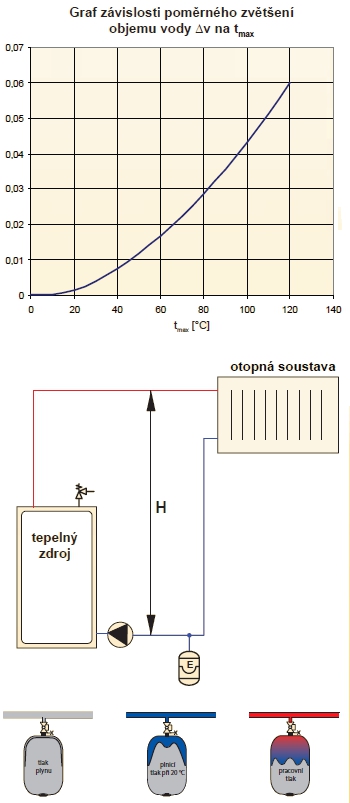Expansion Vessel Size Calculation
VOLUME CALCULATION
In order to calculate the expansion vessel size, you need to know the following values:
- V - water volume of the entire heating system (boiler, piping, heating radiators, other devices) [l]
- Tmax - max. operating temperature of the heating system [C°] - seek the respective Δv [-] value in the graph
- ph,dov - max. working pressure in the heating system (not higher than the value of the safety valve in your boiler room) [bar]
- H - elevation of the heating system's highest point above the expansion vessel [m].
- ph,min - min. required pressure in the boiler room (set by the boiler manufacturer) [bar]
Other quantities used in the calculation:
- Δv........ relative water volume increase if heated from 10°C to the max. water temperature in the heating system Tmax [-]
- Ve......... pressure expansion vessel volume [l]
Procedure:
- Establish the min. pressure in the boiler room. Compare the required min. pressure required by the boiler manufacturer with the value of H/10. Take the higher of these two values and increase it by 0.2. The result is the min. boiler room pressure ph,min.
- Read the Δv value from the known temperature Tmax in the chart.
- Calculate the expansion vessel volume using the formula:

- Select the nearest bigger size from the expansion vessel line.
- Prior to installation of the expansion vessel (or prior to filling the heating circuit at the latest) adjust the pressure in the expansion vessel from the pre-charge value to ph,min.
- Fill the heating system with cold water and after air bleeding adjust the pressure to ph,min+0,2.
Remember, the higher is the difference between ph,dov and ph,min, the smaller pressure fluctuations will appear in the system but the expansion vessel will have to be bigger.
Example:
The water volume in a heating system is 200 l, its max. working temperature is 80°C, max. pressure in the system is 2.5 bar, the system highest point is 7 m above the boiler room, min. boiler pressure is 0.5 bar.
- Boiler room min. pressure minus 0.5 bar is less than 7/10, ph,min = 7/10+0.2=0.9 bar
- Δv from the chart for 80°C is 0.029.
- Ve= 1.3*200*0.029*(2.5+1)/(2.5-0.9) = 16.5 l
- Select the nearest bigger vessel from the line, i.e. HS018231
- Adjust the pressure in the expansion vessel (empty) to 0.9 bar
- Fill the heating system and after air bleeding adjust the pressure to 0.9+0.2=1.1 bar
The calculation presumes a heating system layout as in the Fig., the boiler room with a boiler and expansion vessel at the lowest point of the heating system. For a different layout the calculation is done in the same manner, related to the position of the expansion vessel, and for other heating system components the hydrostatic pressure difference shall be taken into account.
An expansion vessel for drinking water shall be designed in the same way, just substituting the min. pressure by water mains pressure or switch-off pressure of a whole house water pressure boosting pump; instead of the heating system volume the volume of a DHW heater and re-circulation piping shall be used. If the water mains pressure is too high and the calculated expansion vessel size is too big, a pressure reducing valve shall be used.
